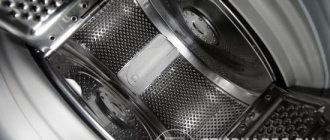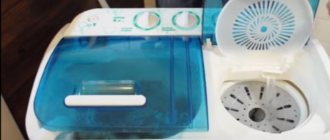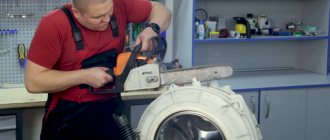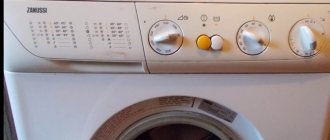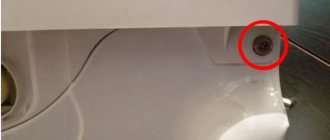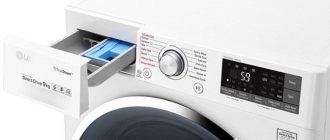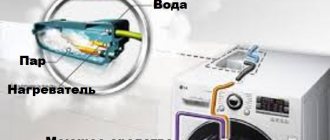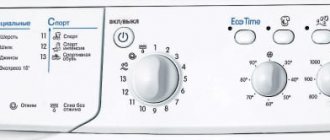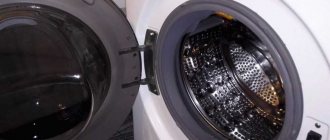Before scientific and technological progress began to steadily gain momentum, washing methods and detergents were primitive. The first washing machine radically revolutionized human life and confidently entered people's homes. If you are interested in the history of its creation, you have come to the right place - we will tell you the most interesting moments of the appearance of washing machines.
Orientation information
Before going to the store, the buyer should have at least a rough idea of what type of equipment he needs. Otherwise, you can only fall for the tricks of sellers. And you don’t buy what you need.
But it is almost impossible to deceive buyers who have been prepared in advance. They already know what to look for, at least minimally, but they understand technology. Let's start our consideration with the parameters that should first attract the attention of buyers.
- Price.
Everyone wants their purchase to cost as little as possible. The main thing is not to get carried away with saving. After all, each additional function costs its money, as does the final quality of the product.
- Dimensions.
The size of the washing machine also matters for those who choose it. Future owners are often willing to put up with technical shortcomings if the device is placed without problems where there is especially little free space. Sometimes it is better to buy a small car than to continue living without it at all. And there is some reason in such explanations.
- Reliability.
This concept is very relative. For some, reliability is associated with the brand under which the models are produced. Others pay attention to the assembly location. Still others look closely at objective criteria that can influence the final result.
- Appearance.
This factor also occupies not the last place. Many users choose a beautiful and unusual design, while technical characteristics fade into the background.
- Brand.
In many ways, the choice depends on how well-known and advertised the manufacturer is. Often technology is chosen simply because it is shown too often on TV, in all media. Although the technical parameters, again, are inferior to analogues.
- Special promotions.
This trick is used by sellers to attract attention to their product.
The above describes the basic parameters that everyone who is thinking about purchasing pays attention to. Or which are more often talked about by those involved in production. There are additional characteristics that deserve special consideration.
- Features related to management.
- Functions and programs. Their composition and total quantity are important.
- The noise level emitted during operation.
- Drum design, capacity level.
- The type of loading scheme used.
Cars with engine
Washing has changed dramatically since motorized washing machines appeared. Some of them were gasoline, the rest were electric.
The “Thor” model, assembled in Chicago in 1908, entered serial production. The creator of the machine, A. Fisher, was known as the inventor of a unique technology at that time.
In the early 20s of the last century, in the USA alone there were more than 1,300 organizations that launched the production of SM. Not everyone was destined to firmly consolidate their position in the market, so not many have reached this day. Among the “old-timers” of the washing machine market we can highlight.
The improvement of washing machines continued - all dangerous parts and components were gradually hidden and covered with panels, the appearance of the equipment was increasingly conducive to purchasing it.
Such a “boom” provoked changes in the social structure of society - after the invention of most household appliances, there was no longer a need for servants, and the queues in laundries disappeared, most of them closed. By the mid-50s, 1.4 million units of washing equipment were sold. At that time, the cost of the machine was $60.
It is difficult to say who created the first machine - the history of this technology covers entire countries and too many inventors and entrepreneurs. And it is almost impossible to decide when the first machine appeared - due to the fact that the first inventions bore little resemblance to the current SMA.
Where is the hatch located on washing machines?
Modern automatic washing machines can be divided into two main groups: vertical or front loading. Depending on this, the hatch of the device can be located at the top or on the central panel. For some, the question of the boot option used may seem unimportant. But even here there are some nuances, which it is recommended to learn about in advance.
- Vertical loading will be relevant for consumers who want to find the narrowest models that can fit in a small space. The cases of such models are indeed narrower compared to their analogues.
- Horizontal loading allows the machine to fit under the sink. Or under the countertop. Vertical models are most often free-standing.
- Price and drum capacity are factors that are also often tied to the loading method used. Compared to horizontal models, vertical options are often more expensive. For a number of reasons, capacity also varies, sometimes not in favor of vertical products.
- Top-loading machines are easier to maintain. There is no need to bend over when placing laundry inside. But the front designs allow you to use the upper part as an additional shelf. For example, to accommodate special cleaning products.
How the car will look depends on the location of the hatch. The appearance of models with a vertical layout is often simple. But other models are more diverse in this regard.
Dates in the history of washing machines
It is difficult to say for sure who was the first to create a washing machine - in the past, patent offices constantly received applications for registration of devices that made washing easier. They were faintly similar to modern SMA, but they can confidently be called ancestors.
- 1797 The washing board appeared, which lingered in people’s everyday lives for many years and was also widespread in the USSR.
- 1851 American J. King patented the first machine with a rotating drum. Its main feature is a manual drive, launched by a special handle, like a meat grinder. It was this invention that became the first prototype of modern SM.
- 1885 By this year, people from all over the world had patented more than 2,000 devices to make laundry easier. Not every device managed to win its “place in the sun”, and they were rejected or redesigned.
Interesting. A California gold miner created the original washing machine in 1851. This “machine” washed about 10 shirts in one wash. Mules were used as the “engine”. He no longer had to “wash” the gold; instead, he provided laundry services to his colleagues, who paid the enterprising inventor with the gold they found. It is known that the first laundry was opened due to the need for laundry among bachelors. Perhaps this relates to the story of the gold seekers.
- 1861 The first device for wrung out clothes was invented, which consisted of rollers between which wet clothes were rolled. The rollers fit together very tightly, pushing water out of the laundry. Later, rollers were used even in Soviet semi-automatic washing machines.
- Before the onset of the 20th century, the main “drive” was living force - the efforts of people or livestock. William Blackstone's device worked on the same principle. A man from Indiana designed and assembled one of these cars as a birthday present for his wife. This device can easily be called the “great-grandmother” of the modern machine, since it was the first to be mass-produced. William launched the production and sale of his invention for $2.50. The company has developed so successfully that it still produces washing machines today.
Attention! If you're in Eaton, Colorado, visit the Washing Machine Museum, founded by Lee Maxwell. It contains a whole collection of devices from the 20th century. Today you can see more than 600 exhibition items there. The main thing is that they all work, so you can clearly see the principle of operation of each of the machines.
Learning drums
A large family requires washing machines that can hold at least 8 kilograms of laundry at a time. Large drums will also be relevant for those who often have to process bulky items with non-standard dimensions. Experts give several recommendations in this regard.
Before making a purchase, you need to see what items are washed most often and in what quantities. Drums designed for 8 kilograms of dry laundry should be enough in normal household conditions.
It is recommended not only to look at the inner surfaces of the drum, but also to feel it. A smooth surface should be present at the rib punches and cells. If you come across at least a couple of burrs made of metal or plastic, the product should definitely be avoided.
What about the noise level?
Many people prefer quiet home models that can be run not only during the daytime, but also during sleep. But most modern machines are too noisy for night work. And some models are so noisy that even during the day the sounds they make are more like a hammer drill.
To avoid mistakes, buyers should carefully study the instructions included with the equipment. And a description of technical parameters. The noise level for normal washing mode, as well as for spinning, is indicated by most manufacturers in the accompanying documentation. The spin cycle is associated with the loudest noise, so it should be of most interest.
The following tips will help you decide.
- If the description says at least 80-85 DB, then you should refuse to purchase the model.
- Within the spin range, a noise level of 70-75 dB is considered normal.
- It’s good if you can find an option for 60-65 dB. But in this case, the spin speed itself decreases, which can negatively affect the operating results.
It’s better when you have the opportunity to listen to how the equipment works after switching on before making a purchase.
Regarding additional functions with programs
How justified is it to pay attention to the maximum number of functions available to the owner? Here are the following rules.
- Additional and unusual programs always require additional payment when purchasing a particular model. The user must decide for himself whether he is ready to spend extra money.
- The more features supported, the more complex the electronics themselves are. This means the likelihood of failure increases.
- Many features are constantly advertised, but from a practical point of view they are of little use.
It is important for buyers to note what will actually be used in real life. Based on this, it will be easier to decide on the final choice. For most buyers, the following options are most relevant:
- Half load support.
- Simplification of the ironing process.
- Additional protection against children.
- Spin.
- Rinsing.
- Gentle wash.
- Shoe processing.
- Outerwear.
- Quick wash for cotton items.
- Working with synthetics.
- A quick wash that only takes half an hour.
The Eco Bubble function, for example, has not proven its effectiveness in practice either. Therefore, there is no point in spending money on it.
Washing machine programs explained
All washing machines should have the same standard programs, but some brands include additional cycles for specific washes. When choosing a program, keep in mind the recommended temperatures and spin speeds for different fabrics. Here's what some of the most common wash programs do:
- Quick wash
: A complete wash cycle can be completed in just 15 minutes. It's only meant to freshen your laundry - don't expect it to remove stains. - Economy
: To save energy, these programs tend to lower the wash temperature but increase the cycle time. - Hand Wash:
This program is great for machine washing delicate fabrics and knits that you would normally wash by hand. It reduces drum agitation during the wash and spin cycle and washes at a lower temperature. - Extra Rinse
: This setting allows you to increase the number of rinses. This can be very helpful, especially if you have allergies or sensitive skin in your family. - Hot Wash
: This feature typically operates at 60C or higher and is best for removing tough stains and sterilizing clothing.
Features of washing machine control
The main difference between electronic control is the additional panel, which displays all the information regarding the current settings. The electromechanical version of the model only has buttons and indicators; there is no electronic display. Electronic control also involves additional expenses.
But in this case there is additional savings in terms of energy consumption. The program independently selects the parameters according to which you need to organize the rinsing and spinning process.
Each user chooses the interface that is easiest to work with. It is recommended to give preference to models that are easy to understand on an intuitive level. You shouldn’t choose a technique that takes hours to understand.
Information about spin and wash quality
The number of spin revolutions is set depending on what fabric currently requires processing. There are also classes here, starting with A and ending with G. The principle is the same as in the previous case - A is the optimal option. The following letters indicate deterioration in performance.
Finally, the quality of washing is also indicated by letters. The efficiency of washing clothes depends on this. And how carefully the equipment will treat the products placed inside. Class A is the most effective. But the selection of a washing machine according to its parameters should not be based only on this class; there are other factors.
Characteristics of a good washing machine
Drum dimensions
Washing machines are more efficient and energy efficient when they're full, so it's worth thinking about how much laundry you'll be washing at one time. The drum capacity varies from 3 kg to 12 kg, with the weight referring to the dry laundry that can fit in the drum. Many machines hold between 8 and 10 kg.
This is a great size for large families or those who like to wash everything at once. How much laundry you can fit also depends on the program you choose.
Spin speed
The faster the spin, the more water is removed, so clothes don't have to sit in the dryer or on the clothesline for long. It's worth paying attention to the speed, but any machine that spins between 400 and 1,400 rpm will do the job well. Some high-end models can spin up to 1,800 rpm on the cotton program, but higher spin speeds can cost more and are usually noisier.
Energy efficiency
To find out how economical and efficient your new washing machine will be, look at its energy rating. Every new car has one, and newer models tend to be more efficient than older ones.
Currently the rating scale goes from A to G - A being the most energy efficient - but previously it included A+++, A++ and A+. These have been removed to simplify the scale and reflect increasingly cost-effective technologies. Now most cars that were A+++ will be rated B or C, leaving room for new developments and improvements.
Additional recommendations
South Korean products are considered the best when it comes to simple operation. But Italian analogues are the most complex, as practice and numerous reviews show.
Horizontal loading is convenient because it allows you to observe through the glass how the process is progressing. You just need to remember that such options take up more space. And calculate everything in advance. Particularly convenient will be the ability to be built into various sets of furniture for rooms with different purposes.
Buyers should carefully study price tags. They are important, but should not be at the forefront. After all, manufacturers, under the pretext of reducing prices, can sell even defective models. Or options with factory defects, which during further operation only cause additional problems.
It is necessary to take into account in advance the free space that is used to install equipment. Then there should be no problems with determining the appropriate dimensions.

